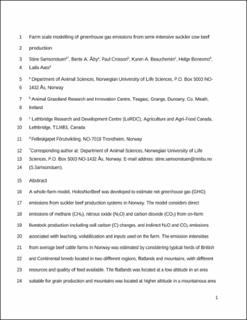| dc.contributor.author | Samsonstuen, Stine | |
| dc.contributor.author | Åby, Bente Aspeholen | |
| dc.contributor.author | Crosson, Paul | |
| dc.contributor.author | Beauchemin, Karen A. | |
| dc.contributor.author | Bonesmo, Helge | |
| dc.contributor.author | Aass, Laila | |
| dc.date.accessioned | 2020-11-05T14:23:10Z | |
| dc.date.available | 2020-11-05T14:23:10Z | |
| dc.date.created | 2019-09-20T11:23:52Z | |
| dc.date.issued | 2019 | |
| dc.identifier.issn | 0308-521X | |
| dc.identifier.uri | https://hdl.handle.net/11250/2686621 | |
| dc.description.abstract | A whole-farm model, HolosNorBeef was developed toestimate net greenhouse gas (GHG) emissions from suckler beef production systems inNorway. Themodel considersdirectemissions ofmethane (CH4),nitrous oxide(N2O) and carbon dioxide (CO2) fromon-farm livestock production including soilcarbon (C) changes, and indirectN2O and CO2 emissions associated with leaching, volatilization and inputs used on the farm. The emission intensities from average beef cattle farms in Norway was estimated by considering typical herds of British and Continental breeds located in two different regions, flatlands and mountains, with different resources and quality of feed available. The flatlands was located at a low altitude in an area suitable for grain production and mountains was located at higher altitude in a mountainous area not suitable for grain production. The estimated emission intensities were 29.5 and 32.0kg CO2 equivalents (eq) kg‐1 carcass for the British breeds and 27.5 and 29.6kg CO2 eq kg‐1 carcass for the Continental breeds, for flatlands and mountains, respectively. Enteric CH4 was the largest source accounting for 44–48% of total GHG emissions. Nitrous oxide from manure and soil was the second largest source accounting for, on average, 21% of the total emissions. Carbon sequestration reduced the emission intensities by 3% on average. When excluding soil C the difference between locations decreased in terms of GHG emission intensity, indicating that inclusion of soil C change is important when calculating emission intensities, especially when production of feed and use of pasture are included. | en_US |
| dc.language.iso | eng | en_US |
| dc.rights | Attribution-NonCommercial-NoDerivatives 4.0 Internasjonal | * |
| dc.rights.uri | http://creativecommons.org/licenses/by-nc-nd/4.0/deed.no | * |
| dc.title | Farm scale modelling of greenhouse gas emissions from semi-intensive suckler cow beef production | en_US |
| dc.type | Peer reviewed | en_US |
| dc.type | Journal article | en_US |
| dc.description.version | acceptedVersion | en_US |
| dc.source.volume | 176 | en_US |
| dc.source.journal | Agricultural Systems | en_US |
| dc.identifier.doi | 10.1016/j.agsy.2019.102670 | |
| dc.identifier.cristin | 1727136 | |
| dc.relation.project | NMBU - Norges miljø- og biovitenskapelige universitet: PhD-stipend | en_US |
| cristin.unitcode | 192,10,1,0 | |
| cristin.unitname | Institutt for husdyr- og akvakulturvitenskap | |
| cristin.ispublished | true | |
| cristin.fulltext | postprint | |
| cristin.qualitycode | 1 | |

